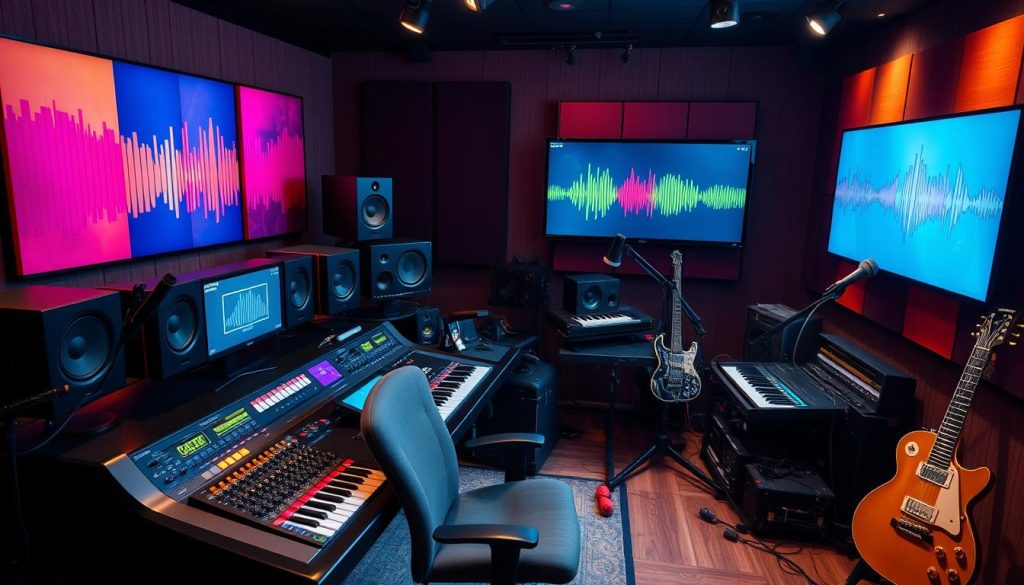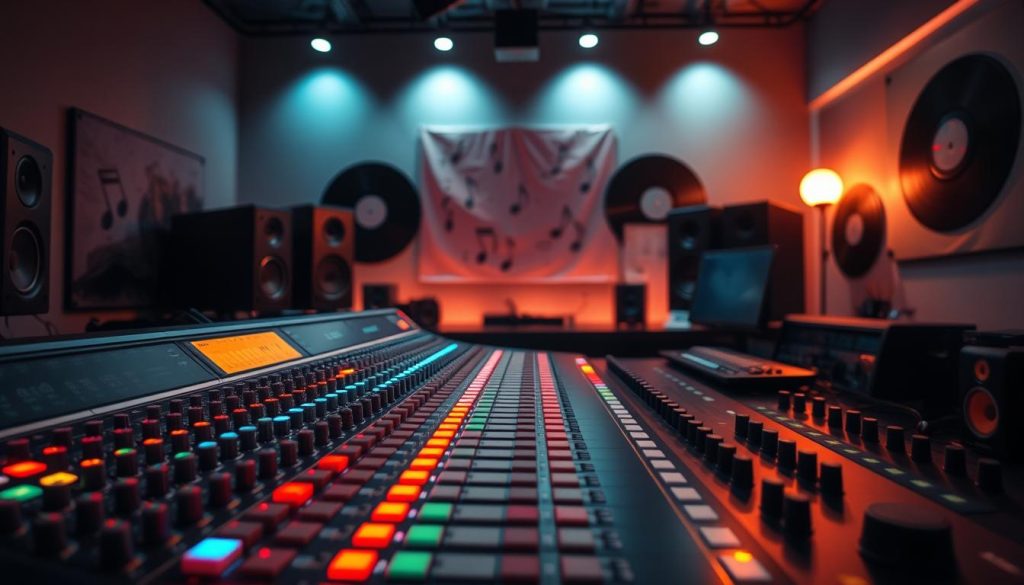Starting in music production can be thrilling and a bit scary. But don’t worry, I’m here to help you. With the right steps and a desire to learn, you can quickly get good at mixing. Mixing is more than just turning up volumes, tweaking EQ, and adding effects. It’s a full process that includes sound design, arrangement, and listening carefully.
I’ll show you the basics of mixing to help you improve your audio work. It doesn’t matter if you’re in a pro studio or recording at home. Mixing follows the same rules everywhere. With time and a good ear, you’ll get better at making your tracks sound great. You’ll make each part stand out and create a mix that flows well.
Let’s begin your audio journey together. With every mix, you’ll understand mixing better and develop your own style. Face challenges, ask for feedback, and enjoy making music. The more you mix, the more skilled and sure you’ll become. This will help you bring out the best in your music.
Understanding the Mixing Process
As an aspiring musician or audio enthusiast, it’s key to know how mixing works. Mixing means balancing and shaping song tracks to sound great together. It’s not just about adding cool effects. It’s about using tools like volume, panning, EQ, and compression to highlight your music’s best parts.
What is Mixing?
Mixing blends and adjusts audio tracks in a song for a polished sound. You tweak volume, pan, tone, and dynamics to make each part fit well together. This makes the music sound balanced and pleasing to the ear.
Goals of Mixing
- To balance the individual tracks within a song, creating a cohesive, unified sound.
- To shape the emotional impact of the music, enhancing the listener’s experience.
Good mixing isn’t just about adding cool effects. It’s about using tools to improve each element’s natural sound. By mastering mixing, you can make your music stand out. Every instrument and vocal will shine in its own way.
| Mixing Technique | Description |
|---|---|
| Volume | Adjusting the overall level of each track to create a balanced mix. |
| Panning | Positioning each element in the stereo field to create depth and width. |
| Equalization (EQ) | Boosting or cutting specific frequencies to shape the tone of each track. |
| Compression | Reducing the dynamic range of a track to control its volume and impact. |
Preparing Your Session for Mixing

Starting to mix music needs careful planning for a smooth process. Organizing tracks and setting up bussing and routing are key steps. These steps greatly improve your mix’s quality.
Organizing Your Tracks
First, organize your tracks well. Put similar sounds together, like all drums or guitars. This makes mixing easier and keeps your session clear. Use colors to help see your tracks better.
Bussing and Routing
Good bussing and routing are vital for mixing. Make subgroups or “busses” for certain sounds. This lets you adjust them together, like drums or vocals. Routing tracks right makes mixing smoother and helps you make better choices.
Gain Staging
Gain staging is key for a good mix. Make sure each track’s level is just right, without too much noise. This gives you a solid base for mixing, letting you focus on creativity.
Using Reference Tracks
Using reference tracks can change your mix. Compare your work to well-made tracks in the same style. This helps you see what’s missing and improve your mix’s quality.
Preparing your mix well sets you up for success. The effort you put in now helps as you work on your mix. It makes getting the sound you want easier.
Volume Balance: The Foundation of a Great Mix

Getting the right volume balance is key to a professional mix. It’s the base for all other mixing choices. By balancing your tracks, you make a clear sound that lets each part stand out.
Start by solo-ing each track and adjusting its level. Make sure it fits well in the mix. Pay attention to how your mix levels compare to each other. This mix balance keeps your mix clear and strong.
After setting the volume balance, use reference tracks to fine-tune your mix foundation. Compare your mix to well-known songs to spot any issues. Adjust your mixing levels until it sounds good on different systems.
- Solo each track and adjust its level for optimal volume balance.
- Ensure no single element is overpowering the others – maintain a cohesive mix balance.
- Use reference tracks to fine-tune your mix foundation and mixing levels.
Getting the perfect volume balance takes time and trial. But once you get it, your mixes will sound rich, balanced, and professional.
Taming Dynamics with Compression
Compression is a key tool in audio mixing. It helps control the loudness of our tracks for a balanced sound. We’ll look at how a compressor works and how to use it in your mixes.
Anatomy of a Compressor
A compressor reduces loud sounds above a set level. It has important parts like the threshold, ratio, attack, and release controls. These help shape your audio’s dynamics, letting you adjust the mix’s tone and balance.
Applying Compression to Your Tracks
Using compression right is crucial. Too much makes sounds flat, while not enough makes them uneven. I suggest trying different settings on each track to find the right balance.
Learning compression can open up new sounds. It’s great for adding punch to drums, smoothing vocals, or mixing everything together. With practice, you’ll make mixes that are dynamic and engaging.

